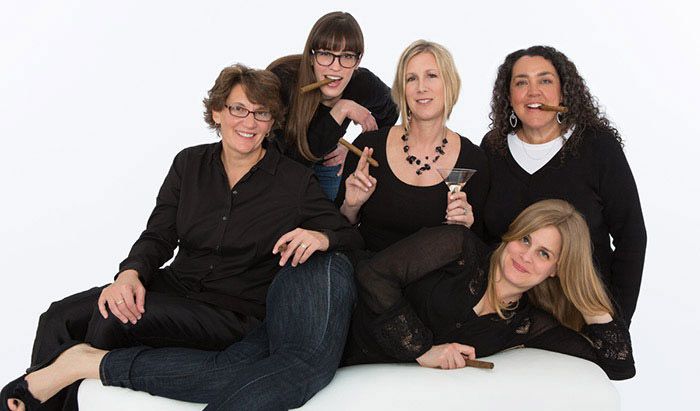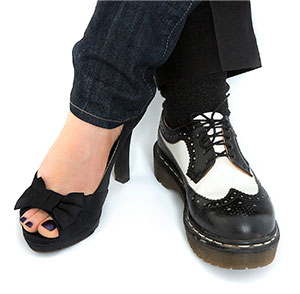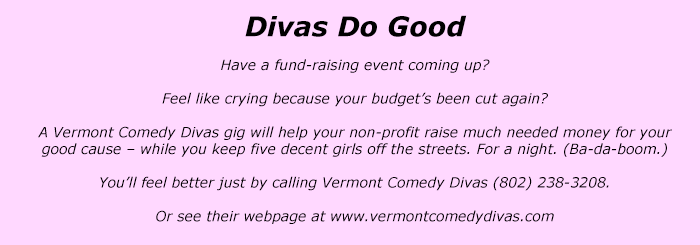A Funny Thing Happened on the Way to Vermont Comedy Divas |
|||
by Cindy Ellen Hill |
|||
Vermont Comedy Divas (from left to right) |
|||
“Even as a little kid I tried to make people laugh,” says Josie Leavitt, founder of the Vermont Comedy Divas, the country’s only all-female touring standup comedy troupe. “People like you when you make them laugh. In the second grade, at a talent show, a friend and I did this tap-dancing routine to “Tea for Two.” And half way across the stage, we just burst out laughing. Then the audience started laughing with us, and it was a really heady feeling.” That heady feeling stuck in the back of Leavitt’s mind until her now-ex-wife pressed her to do open mic in New York City. Afterwards, she plunged into a standup class, and begged the Stand Up NY Comedy Club to put her in a show. It finally relented, giving her a brief warm-up slot, and she worked her way up the ladder. Work is the word for it. “I take comedy seriously. It’s an art. It’s work. You don’t just wing it. I’ll write every day,” Leavitt explains. Co-owner of Flying Pig Bookstore in Shelburne, she multitasks. “I have notes all over the cash register, all over the counter. Then I’ll go through those notes and see what there is for material. If it’s a show week, I practice in the car. It looks like I’m driving along, talking to myself. Then I practice at home using a microphone and mic stand, wearing the shoes I’m going to wear. I check the timing.” Despite the drudgery, our Vermont Divas are embracing an undeniable calling. “All of us couldn’t NOT do comedy,” Leavitt says.” And it’s fun.” Birth Of The Divas Leavitt founded the Divas in 2006 after she “got tired of opening for other people.” Today the Divas include Tracie Spencer, Autumn Engroff Spencer [no relation], Carmen Lagala, and Sue Schmidt, as well as Leavitt, the only remaining original member. Having five members gives the Divas flexibility to pull together performers for out-of-town shows. “It’s working out well,” Leavitt says. “We have bookings out to May.” Bookings are enhanced by the troupe’s charity wing, Divas Do Good. Charity gigs provide an easy pre-packaged fundraiser event for non-profit organizations, and make money for both the charity and the comedians. They’ve done 15 charity performances their first year, with a September 13 event scheduled for the Chittenden County Humane Society at the Flynn Space, and a September 19 event at the Old Lantern in Charlotte to benefit the Brain Cancer Research Foundation. (Vermont has the highest brain cancer rate in the nation—not funny.) While Leavitt has been doing Divas for seven years, Sue Schmidt became, at 51, the group’s latest addition, after deciding about a year ago to take a standup class at the Flynn. A mental health counselor by trade, Schmidt now heads the Green Mountain Performing Arts Center in Waterbury. “Comedy is really hard,” she says. “I’m a musician too, and comedy is different from other performing arts. People see you dance or play music, and they think, man, I wish I could do that. The skills necessary for it are fairly obvious. But with comedy, everyone who sees you thinks they actually can do it.” Timing, cadence, body language, and the production of great volumes of appropriate material are not readily apparent to the undiscerning.
A Wacky History Richard Zoglin’s documentary, History of Stand-Up Comedy in America at Time.com, calls standup the great American art form. But the all-male chronology he presents—Bob Hope, Henny Youngman, Jack Benny, Mort Sahl, Lenny Bruce, George Carlin, Richard Pryor, Steve Martin, Jerry Seinfeld—is wacky without women. Yael Kohen wrote We Killed: The Rise of Women in Comedy after discovering that absence. Notable funny women abounded; they had just been left out of histories written by men. Phyllis Diller’s arrival on the stage in the 1950s mocking husbands was revolutionary in a sea of men joking about wives and mothers-in-law, Kohen writes. Joan Rivers and Lily Tomlin stretched the role of the female comic. Then came Elaine Boosler, Roseanne Barr and Ellen DeGeneres. Comics Janeane Garafolo and Margaret Cho shocked, while Whoopi Goldberg went from standup to acting. Today, women’s standup styles range from self-deprecating angst about hair, weight, and fashion to cutting political satire. Yet women’s comedy began long before standup, and women have joked from comedy stages long before the invention of the microphone. Women and men comics performed together as the Doric Mimes travelling ancient Greece, and later in the Phylax Players of southern Italy. The Glee-maidens of medieval England were as popular as Glee-men, and family teams often performed together. Notable female comic Adeline received a handsome estate from William the Conqueror, while Marie de France held audiences with Henry III and William I, also known as William Longsword. Fools Abide According to Dana Fradon, New Yorker cartoonist and author of The Kings Fool: A Book About Medieval and Renaissance Fools, one of the few class-crossing professions open to women in medieval times was comedic performer. One of the most famous and extravagantly rewarded female jesters, Mathurine, served three French kings—Henry III, Henry IV, and Louis XIII. La Jardiniere served Mary Queen of Scots at her Scottish estate, and Queen Mary of England (1553-1558) had a female court jester named Jane, who lived in the royal quarters. “The court jester is a universal phenomenon,” writes Beatrice K. Otto, whose book, Fools are Everywhere: The Court Jester Around the World, grew out of her post-graduate study of Chinese culture. Jesters—like today’s comedians—were licensed to speak their minds without fear of punishment, and could reflect on the folly of governmental actions without fear of reprisal, unlike, say, someone named Snowden. The official job title of jester died out as a court institution in early 17th-century China and 18th-century Europe. The expansion of public theater and the growth of traveling shows in America and elsewhere brought upper class comedy out of the exclusive realm and into the bowels of democracy, joining Punch and Judy.
Wild, Wild World Women performers were notable in the traveling variety and Wild West shows between the American Revolution and the Civil War, though often as the comic foil for male magicians or other stage performers. The post-Civil War era ushered in vaudeville, and by the 1880s women were back on center stage. The comedic women of vaudeville drew top billing, high wages, and huge audiences. Eva Tanguay, the highest paid vaudeville performer, engaged in raunchy sex-laden skits and music that had audiences rolling with laughter. Marie Dressler brought comic opera into vaudeville, while May Irwin launched the ragtime craze, and gleefully shared in the first filmed kiss. While these were all skit-performers rather than standups, their sexual wit and wild-woman antics were clearly in the court-jester mode. Mae West, for example, ran counter to social mores and generated audience laughs from uncomfortable truths. Female comics helped carry the suffragist movement to victory. Diva Sue Schmidt says, “Across history, when you look at comedy from a social perspective, it’s moved our culture forward in so many ways, from women’s issues to gay rights and all kinds of social issues. That’s never been more apparent than today in countries where human rights are not at the forefront, and where there is also a lack of [open] comedic tradition.” Out of Bounds Reasonable and intelligent people can vary in their opinions of what is comedically appropriate or out of bounds. Each of the Vermont Comedy Divas has her own boundaries as to what belongs on stage. “My career as a therapist is very hard-line. It’s very, very serious, and so how you use humor in the practice of mental health is a delicate issue,” Schmidt says. “But there is absolutely a place for it. I never, ever use stuff people tell me in therapy on stage. That’s just a bright line there. Humor does have its limits.” One of those limits for Josie Leavitt is to never make fun of a group of which you’re not a member. Another is the rape jokes popular amongst male comedians. “I don’t like rape jokes. They really have to stop,” she says. “It makes me nervous that our culture finds that so humorous. I called a comic out on that. It’s just not funny. I don’t like racist humor either.” Comic Anxiety Sometimes, however, you just can’t please everyone no matter how conscientious you are about your material. “I had an exchange with a grandmother a while ago,” Leavitt recounts. “I had done an all-ages show at the Flynn, and there were a lot of kids there, and I had a line about dogs pooping in the house. So this grandmother came into the bookstore, and said she liked me as a gay comic, as her grandson is gay, and then says, ‘But then you had to go and use the word poop.’” A show that falls flat is the comic’s worst nightmare. It can stem from a disconnect between life and “material.” “I know one comic whose mom had died, and he was trying to go on, and I said look, maybe you need a break. Or last year, when I was getting divorced, and was going on stage. …It was none of anybody’s business, so I just wasn’t talking about it,” Leavitt says. “But it can also be an escape. We say, leave it on the stage.” A show falling flat calls into play the standup’s intelligence and fast thinking. “You have to change gears, talk to the audience, take a sip of water, breathe, regroup, think on your feet,” Leavitt says. “But sometimes the show doesn’t work, and you hear crickets.”
Beating the Odds Despite women’s venerable comic history, female comedians remain a minority. “For every ten comics in a show, you’re lucky if two are women,” Leavitt says. Seven Days this past May did only slightly better, featuring five men and two women in their “Seven Comics to Watch at the 2013 Green Mountain Comedy Festival.” One was Carmen Lagala, a member of Vermont Comedy Divas and winner of this year’s Higher Ground Comedy Battle. Women’s voices in comedy are heard about as frequently as women’s voices in entertainment, where they comprise less than 30 percent of speaking roles in American-made film. Numbers of women’s speaking roles in film are actually dropping, but female comedians, at least, appear to be on the rise. “The number of women comedians is growing. You see different women every week at the open mics,” Leavitt says. Barriers remain. “Standup has historically been dominated by men,” Schmidt says. “Of course there were always women, but people come into a show, and say, ‘Oh look, it’s a woman comic.’ It’s like race. People in Vermont see a black person walk in somewhere, and they say to themselves, ‘Oh look, there’s a black person.’ We can pretend it’s not there, but it is there.” While barriers for women are noticeable, they are not insurmountable. “If you’re funny, gender goes away,” Schmidt says. “And I have never met a male standup who wasn’t gracious and welcoming. The only question is whether you are funny.” She Who Laughs, Lasts Meanwhile male comics may be carving out new political territory: as policy makers. John Avlon, a journalist and commentator for CNN, views Stephen Colbert, Bill Maher, and Jon Stewart as comedians driving, rather than responding to, political debate. “Consider it a sign of the times–laughter and satire is the only sane response to the sickening spin cycle we’re subjected to on a daily basis,” he wrote in a 2010 article published in The Daily Beast, “The Comedian Political Takeover.” Avlon notes that some politicians now take their cues from comedians instead of the other way around. Some politicos model public statements on shock-jock comedy: outrageous words that are thin on truth, but sure to garner intense media attention. “There’s a reason to take comedians seriously as commentators today,” Avlon writes. “Sometimes it feels like they’re the only ones telling the truth.” This latest wave of truth misses women’s voices, however—which may help explain why some members of Congress assume women’s lives remain subject for stupid remarks that then make for satire. While the male TV stars who drive the political agenda are well-paid, most standup comics are not. The only way to make a living at it, Leavitt says, “is if it’s all you do, on the road 300 nights a week. I never wanted to live that way. And it’s really competitive, and I’m not really competitive. I’m not always doing a one-woman show. I like performing with others.” As the standup stage calls, however, women comics will rise in answer—even without the big paycheck. “It’s comedy’s time,” Schmidt says. “You can go to seven or eight venues a week in the Burlington area, and see good fresh young comedians every night.” Comedy clubs or not, “Laugh a little bit every day,” Schmidt advises. |
|||
| Cindy Ellen Hill is a writer and attorney in Middlebury. | |||




